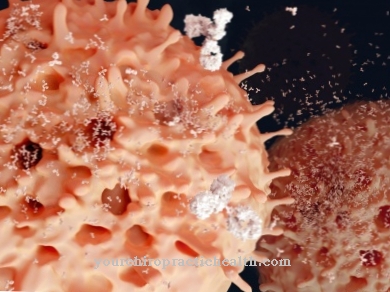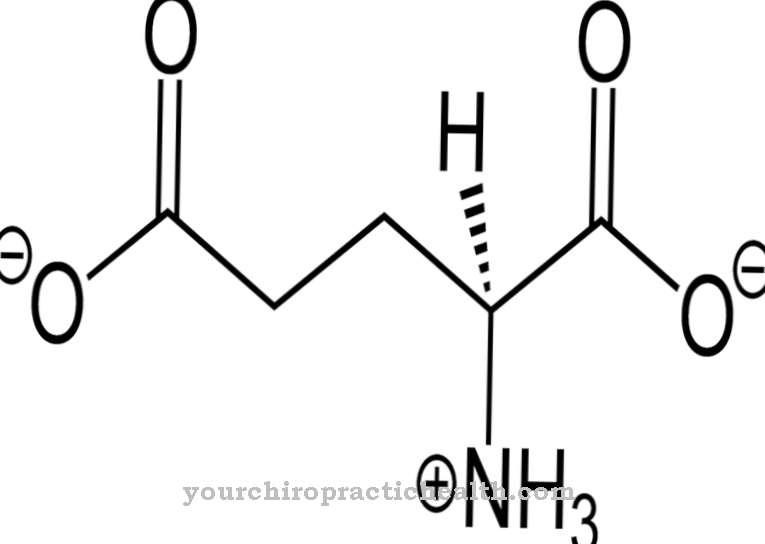Nicotinamide adenine dinucleotide phosphate is a coenzyme that can transfer electrons and hydrogen. It is involved in numerous reactions in the cell metabolism and is formed from vitamin B3 (nicoic acid amide or niacin).
What is nicotinamide adenine dinucleotide phosphate?
Nicotinamide adenine dinucleotide phosphate (actual name Nicotinic acid amide-adenine-dinucleotide-phosphate) is also known as NADP (oxidized form without hydrogen) or NADPH (reduced form with hydrogen) abbreviated. It is an organic molecule and one of the coenzymes.
These substances play an essential role in the function of enzymes. NADP plays a central role in many redox reactions in the energy metabolism of cells: It can bind and transfer electrons and hydrogen in one reaction and serves as a reducing agent (absorbing hydrogen and electrons) and as an oxidizing agent (releasing hydrogen and electrons).
Function, effect & tasks
When building up the body's own substances and tissues (anabolic metabolic pathways), nicotinamide adenine dinucleotide phosphate in its reduced form is used to transfer hydrogen ions and electrons. In the synthesis of fatty acids, NADPH transfers hydrogen to a reactant in a so-called condensation reaction.
This leads to the formation of saturated fatty acids. Fatty acids are formed when the body has enough carbohydrates and energy. The fatty acids are stored in fatty tissue and in the liver, among other things. They have a vital function for the body as energy stores and energy suppliers.
NADPH / NADP also plays a central role in the breakdown of metabolic products to detoxify the organism and to generate energy (catabolic metabolic pathways). When unsaturated fatty acids break down, it is oxidized and releases hydrogen and electrons to a reaction partner. The breakdown of amino acids as building blocks of proteins also takes place in the catabolic metabolism with the participation of NADPH / NADP. When energy is generated in the cells to maintain the metabolic and thus the life processes, glucose (grape sugar) is broken down: this is also only possible with the help of NADP. It serves here as an acceptor for hydrogen and electrons.
Vitamin B3 (niacin) as a precursor of nicotinamide adenine dinucleotide phosphate can be produced by the body itself through the amino acid tryptophan, but in an unfavorable ratio of 60: 1. Accordingly, an intake of vitamin B3 with the food is essential to guarantee adequate NADP / NADPH formation in the body. The need for Vitmain B3 depends on the body's energy expenditure. The more energy the body uses, the more niacin has to be supplied with food.
Education, occurrence, properties & optimal values
Vitamin B3 is particularly found in meat (poultry), fish, eggs and dairy products. Whole grain products, coffee and legumes are also sources of niacin.
In general, the German Nutrition Society assumes an average daily vitamin B3 requirement of around 13 mg for women and the elderly. Pregnant and nursing mothers have an increased requirement of around 17 mg. Men require a daily intake of between 13 and 17 mg, depending on their age, and between 7 and 12 mg for children. The body's need for energy plays a role here, because the need can increase for a short time at higher loads.
With a normal diet, an overdose of niacin is very unlikely. However, this can occur if very high doses of food supplements are consumed. Headache, vomiting, skin symptoms and diarrhea are the first symptoms. A chronic and severe overdose can result in gastric mucosal inflammation and liver damage. Vitamin B3 is not toxic to humans even in high doses.
Diseases & Disorders
If the intake of vitamin B3 is too low, there will be a long-term deficiency of nicotinamide adenine dinucleotide phosphate in the body, since tryptophan is not sufficient as the sole synthesis source in the long term. Deficiency symptoms when there is too little NADPH / NADP in the body show up in symptoms such as weight loss, insomnia, diarrhea and inflammation of the skin.
Overall, with a niacin deficiency and thus NADPh / NADP deficiency, the digestive and nervous systems as well as the skin are affected. If the deficiency in vitamin B3 is severe and persists for a long time, the disease pellagra (pellagra = rough skin) can occur. In this disease there are symptoms of the nervous system such as tremors, cramps, paralysis and mental disorders up to dementia. Inflammatory skin changes, thickening, redness, itching and brown discoloration in areas exposed to sunlight (face, neck, forearms, hands) are also typical. The disease usually develops slowly over the years, as the body can compensate for the niacin deficiency for a long time by breaking down tryptophan.
In extreme cases, Pellagra can lead to death within a few weeks. Today the disease rarely occurs. It is mainly found in regions where corn and millet are consumed as staple foods, as they do not contain vitamin B3. With a normal diet, a niacin deficiency and thus a too low level of nicotinamide adenine dinucleotide phosphate in the body is very rare. Treatment consists of direct administration of vitamin B3 and a diet rich in niacin. Alcoholism can also lead to a niacin deficiency and thus to a deficiency of NADPH / NADP in the organism.
In the case of high alcohol consumption, a diet high in vitamin B3 is accordingly advisable. Certain hereditary diseases such as Hartnup syndrome are another cause of niacin or NADPH / NADP deficiency in the body. In this case, vitamin B3 cannot be absorbed normally by the organism and drug therapy is indispensable.


.jpg)









.jpg)



.jpg)










.jpg)
